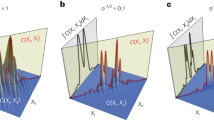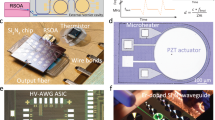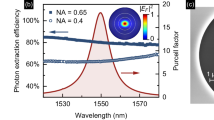Abstract
Optoelectronic devices that provide non-classical light states on demand have a broad range of applications in quantum information science1, including quantum‐key‐distribution systems2, quantum lithography3 and quantum computing4. Single-photon sources5,6 in particular have been demonstrated to outperform key distribution based on attenuated classical laser pulses7. Implementations based on individual molecules8, nitrogen vacancy centres9 or dopant atoms10 are rather inefficient owing to low emission rates, rapid saturation and the lack of mature cavity technology. Promising single-photon-source designs combine high-quality microcavities11 with quantum dots as active emitters12. So far, the highest measured single-photon rates are ∼ 200 kHz using etched micropillars13,14. Here, we demonstrate a quantum-dot-based single-photon source with a measured single-photon emission rate of 4.0 MHz (31 MHz into the first lens, with an extraction efficiency of 38%) due to the suppression of exciton dark states. Furthermore, our microcavity design provides mechanical stability, and voltage-controlled tuning of the emitter/mode resonance and of the polarization state.
This is a preview of subscription content, access via your institution
Access options
Subscribe to this journal
Receive 12 print issues and online access
$209.00 per year
only $17.42 per issue
Buy this article
- Purchase on Springer Link
- Instant access to full article PDF
Prices may be subject to local taxes which are calculated during checkout





Similar content being viewed by others
References
Bouwmeester, D., Ekert, A. K. & Zeilinger A. The Physics of Quantum Information (Springer, Berlin, 2000).
Gisin, N., Ribordy, G., Tittel, W. & Zbinden, H. Quantum cryptography. Rev. Mod. Phys. 74, 145–195 (2002).
Boto, A. N. et al. Quantum interferometric optical lithography: exploiting entanglement to beat the diffraction limit. Phys. Rev. Lett. 85, 2733–2736 (2000).
Knill, E., Laflamme, R. & Milburn, G. J. A scheme for efficient quantum computation with linear optics. Nature 409, 46–52 (2001).
Lounis, B. & Orrit, M. Single-photon sources. Rep. Prog. Phys. 68, 1129–1179 (2005).
Shields, A. J. Semiconductor quantum light sources. Nature Photon. 1, 215–223 (2007).
Waks, E. et al. Quantum cryptography with a photon turnstile. Nature 420, 762 (2002).
Lee, T.-H. et al. Oriented semiconducting polymer nanostructures as on-demand room-temperature single-photon source. Appl. Phys. Lett. 85, 100–102 (2004).
Kurtsiefer, C., Mayer, S., Zarda, P. & Weinfurter, H. Stable solid-state source of single photons. Phys. Rev. Lett. 85, 290–293 (2000).
Strauf, S. et al. Quantum optical studies on individual acceptor bound excitons in a semiconductor. Phys. Rev. Lett. 89, 177403 (2002).
Vahala, K. Optical microcavities. Nature 424, 839–846 (2003).
Michler, P. et al. A quantum dot single-photon turnstile device. Science 290, 2282–2285 (2000).
Pelton, M. et al. Efficient source of single photons: A single quantum dot in a micropost microcavity. Phys. Rev. Lett. 89, 233602 (2002).
Santori, C. et al. Submicrosecond correlations in photoluminescence from InAs quantum dots. Phys. Rev. B 69, 205324 (2004).
Stoltz, N. G. et al. High-quality factor optical microcavity using oxide apertured micropillars. Appl. Phys. Lett. 87, 031105 (2005).
Yuan, Z. et al. Electrically driven single-photon source. Science 295, 102–105 (2002).
Chang, W.-H. et al. Efficient single-photon sources based on low-density quantum dots in photonic-crystal nanocavities. Phys. Rev. Lett. 96, 117401 (2006).
Takemoto, K. et al. An optical horn structure for single-photon source using quantum dots at telecommunication wavelength J. Appl. Phys. 101, 081720 (2007).
Colvin, V., Schlamp. M. & Alivisatos, A. P. Light-emitting diodes made from cadmium selenide nanocrystals and semiconducting polymer. Nature 370, 354–357 (1994).
Strauf, S. et al. Self-tuned quantum dot gain in photonic crystal lasers. Phys. Rev. Lett. 96, 127404 (2006).
Gur, I., Fromer, M. A., Geier, M. L. & Alivisatos, A. P. Air-stable all inorganic nanocrystal solar cell processed from solution. Science 310, 462–465 (2005).
Urayama, J., Norris, T. B., Singh, J. & Bhattacharya, P. Observation of phonon bottleneck in quantum dot electronic relaxation. Phys. Rev. Lett. 86, 4930–4933 (2001).
Smith, J. M. et al. Voltage control of the spin dynamics of an exciton in a semiconductor quantum dot. Phys. Rev. Lett. 94, 197402 (2005).
Warburton, R. et al. Optical emission from a charge-tunable quantum ring. Nature 405, 926–929 (2000).
Holtz, P. O. et al. Enhanced luminescence from InAs/GaAs quantum dots. Proc. SPIE 6401, 64010I (2006).
Waks, E., Santori, C. & Yamamoto, Y. Security aspect of quantum key distribution with sub-Poissonian light. Phys. Rev. A 66, 042315 (2002).
Moreau, E. et al. Single-mode solid-state single photon source based on isolated quantum dots in pillar microcavities. Appl. Phys. Lett. 79, 2865–2867 (2001).
Unitt, D. C., Bennett, A. J., Atkinson, P., Ritchie, D. A. & Shields, A. J. Polarization control of quantum dot single-photon sources by means of dipole-dependent Purcell effect. Phys. Rev. B 72, 033318 (2006).
Zrenner, A. et al. Coherent properties of a two-level system based on a quantum-dot photodiode. Nature 418, 612–614 (2002).
Acknowledgements
We would like to thank D. Cohen for fruitful discussions. This work was supported through DARPA, NSF and ARO grants.
Author information
Authors and Affiliations
Corresponding author
Supplementary information
Supplementary Information
Supplementary information and figures S1, S2 (PDF 170 kb)
Rights and permissions
About this article
Cite this article
Strauf, S., Stoltz, N., Rakher, M. et al. High-frequency single-photon source with polarization control. Nature Photon 1, 704–708 (2007). https://doi.org/10.1038/nphoton.2007.227
Received:
Accepted:
Published:
Issue Date:
DOI: https://doi.org/10.1038/nphoton.2007.227
This article is cited by
-
Dynamical control of nanoscale light-matter interactions in low-dimensional quantum materials
Light: Science & Applications (2024)
-
Self-assembling structures close the gap to trap light
Nature (2023)
-
Single-emitter quantum key distribution over 175 km of fibre with optimised finite key rates
Nature Communications (2023)
-
Quantum NETwork: from theory to practice
Science China Information Sciences (2023)
-
Quantum interference of identical photons from remote GaAs quantum dots
Nature Nanotechnology (2022)



